Advantages of the Interval Memory Method
Imagine that you could speed up your learning process and improve memorization of the basics, techniques and programming commands.
Today I will tell you how to do this with interval memorization and a free open-source tool called Anki.

Many people point out the benefits of interval memory:
')
For me personally, Anki has become an integral part of the code learning process. I use this method to memorize important ideas from HTML, CSS, JavaScript, and commands from Git and Bash.
At the moment I am in the queue for admission to the Faculty of Law at the University of California at Berkeley, and Anki will definitely figure in my strategy for the study of law.
In this article we will touch on the following topics:
Interval repetitions are designed to solve the problem of forgetting . According to this technique, the new information is best remembered at the very moment when you are about to forget it.
For example, imagine that you do not know which city is the capital of Colombia . And imagine what I am telling you right now, as it is called.
The capital of Colombia is Bogota.
Let's assume that the capabilities of your memory will allow you to remember this new fact - that the capital of Colombia is called Bogota - exactly 20 minutes after you learned it. Then you forget it.
But if after 19 minutes 59 seconds for a cup of coffee, I remind you ...
The capital of Colombia is Bogota.
... the theory of interval memorization states that now you will remember this information for 40 minutes already. And then forget.
But if after 39 minutes and 59 seconds I remind you again that ...
The capital of Colombia is Bogota.
... you can keep in mind this fact from geography for a longer period, say, one hour.
And if we continue in the same spirit, that is, I will remind you that the capital of Colombia, Bogota, is exactly at the moment when you are about to forget, the time between the “dips” in memory will grow exponentially, from hours to days , then by months and years.
And gradually, as the technique says, the knowledge that Bogota is the capital of Colombia will more or less firmly settle in your memory.
This phenomenon - the weakening of memory over time - is known as the forgetting curve . It was discovered by Hermann Ebbinghaus in 1885.
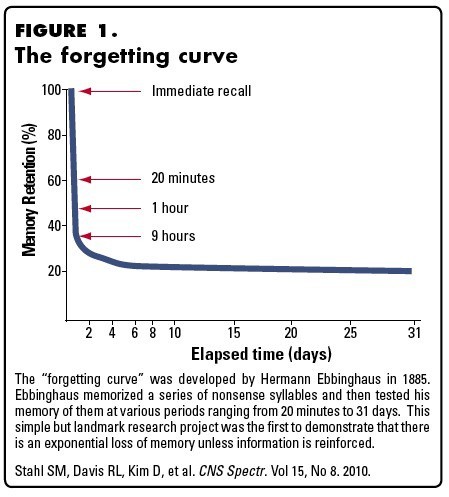
Stahl et al 2010; CNS Spectr
The idea that it is more efficient and effective to break up the learning process into intervals divided by intervals, and not just to memorize material in one step, is known as “interval repetitions”.
Together, the forgetting curve and interval repetitions form the basis of the interval memorization technique.
Depending on your forgetting curve, you determine the optimal interval for reminding yourself of the object of memorization (that is, any quantum of information) and, accordingly, set intervals for fixing one fact or another.
Peter Wozniak, a pioneer in the field of memory research, summarized these ideas as follows:
Now it is logical to ask: “But how to understand when exactly the fact about the capital of Colombia will start to be forgotten? How to find out which time interval will be optimal? ”
Of course, it would be difficult to calculate the interval to a second without a long series of trial and error, as well as scrupulous attention to detail worthy of Darwin. But, fortunately, such meticulousness is not needed, because we can be helped by a good old friend - software. (You can also use a manual method called the Leitner System ).
Software based on colossal memory studies can help you determine the best time to fix your memories. In particular, there is a software designed specifically for interval repetitions.
Anki is an open-source tool for interval memory, created and maintained by Damien Elmes . You can perceive it as a kind of “program with smart flash cards” that uses interval repetitions and makes the memorization process more efficient.
Anki is based on the assumption that knowledge is best stored in memory with periodic reminders that are statically separated in time. In other words, it is made with all the requirements and possibilities of the theory of interval memory.
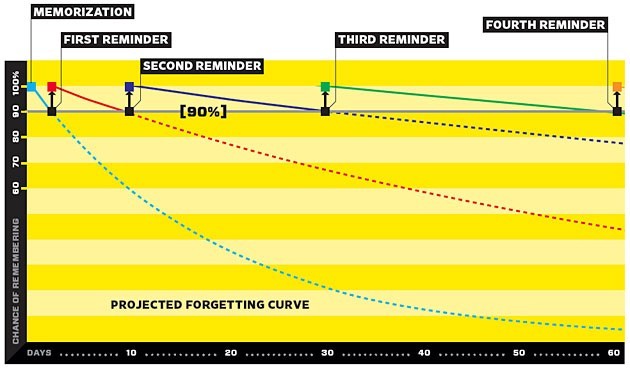
A source
You can use Anki to memorize almost everything you need to remember.
Note, however, that Anki will not replace the learning process. You must first understand the material that you are studying, and then download it into a program that will perfectly help you preserve the acquired knowledge. That is, Anki is a part of the learning process that follows understanding.
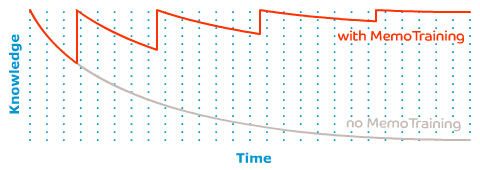
A source
There are other similar programs, for example, SuperMemo , created by the aforementioned Peter Wozniak. Anki essentially repeats the version of the algorithm implemented in SuperMemo .
In the article, I tell about Anki in such detail for three reasons: firstly, I got used to it, secondly, it works without failures, and thirdly, it is free and has open source code. If you used SuperMemo or another tool with the same features, please share your experiences in the comments.
If you also want to use Anki, I, nevertheless, advise you to read about Wozniak and get acquainted with his accurate and insightful observations about memory, the process of learning and creativity .
As for the devices that support the program, Anki has a version for the desktop, and it is recommended to start with it if you have not used similar programs before. But there are other options:
Keep in mind that if you wish, you can study the program much deeper and customize it as you need. I only offer you a cursory review to reveal the essence.
1. You create "decks", which consist of a group of cards of a specific subject. The theme of the deck can be, for example, JavaScript ”or Capitals.
Here is an example of a deck in a desktop application (don't worry, I’ll explain later what New , Learning or To Review means):
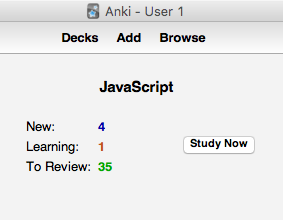
Deck example
2. You add “cards” to your decks, which are customizable with HTML and CSS.
The card can be a standard double-sided flash card. In this case, the program will first show you its front side.

Example of a standard type card - front side
But when you are ready to answer, click on the Show answer button to see the back of the card. Here is an example of a card from the deck with the theme "Capital":

Example of a standard card type - front and back
Tip : there are other types of maps besides double-sided - for example, a training test in which some words are replaced with spaces. This type of card is very convenient, I use it constantly, as it is simple and effective in terms of organizing information.
Another tip : creating cards in Anki is an art form. The more you practice, the better you will get. In general, try to follow the principle of minimum information . Or, if it is simpler, the principle of TP is - Stupidly Clear You need to make your cards maximally simple, since the simple is easier to remember.
3. When done adding cards, start practicing.
Let's go back to the map of Colombia-Bogota to see how this process works.

Choose when you would like to be reminded to repeat
After you hit Show Answer and go to the other side of the card, ask yourself:
How hard was it to answer me?
If you could not remember the answer at all, you should select the Again button - and the program will show you the same card in less than a minute.
If you answer not immediately, straining your memory, you need to select the Good button, then the next time you see the card in less than 10 minutes.
And if you answered without any difficulty, then choose Easy , and you will not see this card within 4 days.
Anki tracks your progress to determine which cards to show and when. This means that the program takes the tedious work of calculating the forgetting curve for each card itself. This is what gives the automation of interval repetitions using software.
It should be noted that you can change some of the interval repetition variables in the program algorithm. This can be done by going to the settings of your deck and changing the parameters that you would like to change (for example, how many cards are shown per day, the length of time intervals, and so on).
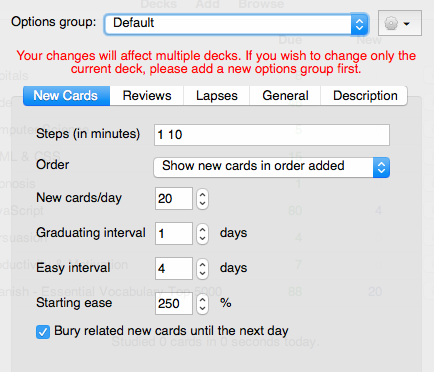
Change deck settings
However, it is possible that at first you should not touch the settings, it is better to just leave everything by default. And later, when you make friends with the program, you can approach the choice of deck settings more creatively.
Now back to our javascript deck:
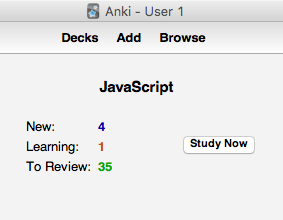
Anki deck example
New means that you have added 4 new maps to your JavaScript deck and can already be used in the learning process.
Learning should be understood as follows: if you are in the process of working with the selected deck, click Good (less than 10 minutes), the program will add this card to the queue in the Learning category and show it in 10 minutes. Read more here.
To Review displays the number of cards in the queue for study.
The more you use Anki, the clearer the whole system becomes.
As for tutorials and instructions, the documentation on the site is just space, it will most likely answer most of your questions. And here are some more useful video tutorials .
Nevertheless, I offer you step-by-step instructions on how to get started with Anki, because step-by-step instructions are a useful thing.
1) Read the article by Derek Siever on interval repetition : it supports the data that I have outlined.
2) An interview with Peter Wozniak will give you a holistic view of interval repetition, learning, and memory research.
3) 20 rules of knowledge formation , from Peter Wozniak will help you to understand the techniques of formulating and structuring Anki cards.
It is important to remember that the interval repetition method is not a substitute for learning. It is very important to first understand the material well before you start using the method. First get hold of it, and then fix it with Anki. Do not forget to use the TP method to create cards, as well as add images to them whenever possible.
4) Create your own decks .
5) Remember that the theme for the deck should be set wide and fairly common . For example, if you are learning JavaScript, do not create a deck called “Closures” and another called “Prototype Inheritance”. Instead, create one “JavaScript” deck. See the Using Decks Appropriately section in the documentation for more information.
6) Start a card with a context in which individual keywords are replaced by spaces - this is a very powerful learning tool.
7) Understand the disadvantages .
Interval repetition has several drawbacks. One of them is a mix of memories.
For example, it is easy to imagine that you will confuse the capitals of Mauritania and Mauritius - after all, these countries have very similar names. It is difficult to completely eliminate the confusion of memories, but you can minimize it by observing the principle of TP.
You can find more information about the flaws here (scroll down to the Downsides section) and here (scroll down to the Combat interference section).
8) Do not forget to synchronize your cards and decks . Select one “source version”, for example, the desktop version, and then synchronize it with the web version of Anki and mobile applications each time you make changes. You make an effort creating cards and decks. Protect yourself from the agony of redoing your own work anew.
9) Enter the work with Anki in the habit . To appreciate all the magic of this program, you need to gather the will into a fist and chase away all your cards day after day. You can even associate Anki with a cup of coffee. Or in the morning. Or with lunch. Or with something else pleasant. Find a way to make Anki a habit.
Today I will tell you how to do this with interval memorization and a free open-source tool called Anki.

Many people point out the benefits of interval memory:
')
- Jeopardy Game Champion! (“His Game” in American) Robert Craig says that he owes his success, among other things, to the Anki program, which he uses to memorize facts.
- John Washam, who runs a blog under the name Googley as Heck , talks about how he actively studied for 8 months to go on an interview at Google, says: “Interval repetitions are the key to remembering ... Periodically returning to the learned material and repeating it , over time, you will become an expert ... Applying this technique, you will reach a level where you simply cannot forget the details. ”
- And Derek Sivers , the founder of CDBaby, writes that the method of interval memory is “the most useful technique that he has met in 14 years of computer programming.”
For me personally, Anki has become an integral part of the code learning process. I use this method to memorize important ideas from HTML, CSS, JavaScript, and commands from Git and Bash.
At the moment I am in the queue for admission to the Faculty of Law at the University of California at Berkeley, and Anki will definitely figure in my strategy for the study of law.
In this article we will touch on the following topics:
- What is interval memorization?
- How does Anki help him?
- And how it can speed up your education and help memorize concepts related to development.
What is interval repetition?
Interval repetitions are designed to solve the problem of forgetting . According to this technique, the new information is best remembered at the very moment when you are about to forget it.
For example, imagine that you do not know which city is the capital of Colombia . And imagine what I am telling you right now, as it is called.
The capital of Colombia is Bogota.
Let's assume that the capabilities of your memory will allow you to remember this new fact - that the capital of Colombia is called Bogota - exactly 20 minutes after you learned it. Then you forget it.
But if after 19 minutes 59 seconds for a cup of coffee, I remind you ...
The capital of Colombia is Bogota.
... the theory of interval memorization states that now you will remember this information for 40 minutes already. And then forget.
But if after 39 minutes and 59 seconds I remind you again that ...
The capital of Colombia is Bogota.
... you can keep in mind this fact from geography for a longer period, say, one hour.
And if we continue in the same spirit, that is, I will remind you that the capital of Colombia, Bogota, is exactly at the moment when you are about to forget, the time between the “dips” in memory will grow exponentially, from hours to days , then by months and years.
And gradually, as the technique says, the knowledge that Bogota is the capital of Colombia will more or less firmly settle in your memory.
This phenomenon - the weakening of memory over time - is known as the forgetting curve . It was discovered by Hermann Ebbinghaus in 1885.

Stahl et al 2010; CNS Spectr
The idea that it is more efficient and effective to break up the learning process into intervals divided by intervals, and not just to memorize material in one step, is known as “interval repetitions”.
Together, the forgetting curve and interval repetitions form the basis of the interval memorization technique.
Depending on your forgetting curve, you determine the optimal interval for reminding yourself of the object of memorization (that is, any quantum of information) and, accordingly, set intervals for fixing one fact or another.
Peter Wozniak, a pioneer in the field of memory research, summarized these ideas as follows:
The optimal intervals are calculated based on two conflicting criteria:
- Intervals should be as large as possible in order to obtain a minimum repetition rate and make the best use of the so-called distribution effect , according to which longer intervals between repetitions, up to a certain limit, help to fix the memories.
- Intervals should be short enough to ensure that knowledge is still stored in memory.
Now it is logical to ask: “But how to understand when exactly the fact about the capital of Colombia will start to be forgotten? How to find out which time interval will be optimal? ”
Of course, it would be difficult to calculate the interval to a second without a long series of trial and error, as well as scrupulous attention to detail worthy of Darwin. But, fortunately, such meticulousness is not needed, because we can be helped by a good old friend - software. (You can also use a manual method called the Leitner System ).
Software based on colossal memory studies can help you determine the best time to fix your memories. In particular, there is a software designed specifically for interval repetitions.
So what is Anki?
Anki is an open-source tool for interval memory, created and maintained by Damien Elmes . You can perceive it as a kind of “program with smart flash cards” that uses interval repetitions and makes the memorization process more efficient.
Anki is based on the assumption that knowledge is best stored in memory with periodic reminders that are statically separated in time. In other words, it is made with all the requirements and possibilities of the theory of interval memory.

A source
You can use Anki to memorize almost everything you need to remember.
Note, however, that Anki will not replace the learning process. You must first understand the material that you are studying, and then download it into a program that will perfectly help you preserve the acquired knowledge. That is, Anki is a part of the learning process that follows understanding.

A source
There are other similar programs, for example, SuperMemo , created by the aforementioned Peter Wozniak. Anki essentially repeats the version of the algorithm implemented in SuperMemo .
In the article, I tell about Anki in such detail for three reasons: firstly, I got used to it, secondly, it works without failures, and thirdly, it is free and has open source code. If you used SuperMemo or another tool with the same features, please share your experiences in the comments.
If you also want to use Anki, I, nevertheless, advise you to read about Wozniak and get acquainted with his accurate and insightful observations about memory, the process of learning and creativity .
As for the devices that support the program, Anki has a version for the desktop, and it is recommended to start with it if you have not used similar programs before. But there are other options:
- AnkiWeb free web application.
- Free Android application synchronized with desktop and web versions.
- For iPhone users on the AppStore there is a paid AnkiMobile application .
How Anki Works
Keep in mind that if you wish, you can study the program much deeper and customize it as you need. I only offer you a cursory review to reveal the essence.
1. You create "decks", which consist of a group of cards of a specific subject. The theme of the deck can be, for example, JavaScript ”or Capitals.
Here is an example of a deck in a desktop application (don't worry, I’ll explain later what New , Learning or To Review means):

Deck example
2. You add “cards” to your decks, which are customizable with HTML and CSS.
The card can be a standard double-sided flash card. In this case, the program will first show you its front side.

Example of a standard type card - front side
But when you are ready to answer, click on the Show answer button to see the back of the card. Here is an example of a card from the deck with the theme "Capital":

Example of a standard card type - front and back
Tip : there are other types of maps besides double-sided - for example, a training test in which some words are replaced with spaces. This type of card is very convenient, I use it constantly, as it is simple and effective in terms of organizing information.
Another tip : creating cards in Anki is an art form. The more you practice, the better you will get. In general, try to follow the principle of minimum information . Or, if it is simpler, the principle of TP is - Stupidly Clear You need to make your cards maximally simple, since the simple is easier to remember.
3. When done adding cards, start practicing.
Let's go back to the map of Colombia-Bogota to see how this process works.

Choose when you would like to be reminded to repeat
After you hit Show Answer and go to the other side of the card, ask yourself:
How hard was it to answer me?
If you could not remember the answer at all, you should select the Again button - and the program will show you the same card in less than a minute.
If you answer not immediately, straining your memory, you need to select the Good button, then the next time you see the card in less than 10 minutes.
And if you answered without any difficulty, then choose Easy , and you will not see this card within 4 days.
Anki tracks your progress to determine which cards to show and when. This means that the program takes the tedious work of calculating the forgetting curve for each card itself. This is what gives the automation of interval repetitions using software.
It should be noted that you can change some of the interval repetition variables in the program algorithm. This can be done by going to the settings of your deck and changing the parameters that you would like to change (for example, how many cards are shown per day, the length of time intervals, and so on).

Change deck settings
However, it is possible that at first you should not touch the settings, it is better to just leave everything by default. And later, when you make friends with the program, you can approach the choice of deck settings more creatively.
Now back to our javascript deck:

Anki deck example
New means that you have added 4 new maps to your JavaScript deck and can already be used in the learning process.
Learning should be understood as follows: if you are in the process of working with the selected deck, click Good (less than 10 minutes), the program will add this card to the queue in the Learning category and show it in 10 minutes. Read more here.
To Review displays the number of cards in the queue for study.
The more you use Anki, the clearer the whole system becomes.
Where to start
As for tutorials and instructions, the documentation on the site is just space, it will most likely answer most of your questions. And here are some more useful video tutorials .
Nevertheless, I offer you step-by-step instructions on how to get started with Anki, because step-by-step instructions are a useful thing.
1) Read the article by Derek Siever on interval repetition : it supports the data that I have outlined.
2) An interview with Peter Wozniak will give you a holistic view of interval repetition, learning, and memory research.
3) 20 rules of knowledge formation , from Peter Wozniak will help you to understand the techniques of formulating and structuring Anki cards.
It is important to remember that the interval repetition method is not a substitute for learning. It is very important to first understand the material well before you start using the method. First get hold of it, and then fix it with Anki. Do not forget to use the TP method to create cards, as well as add images to them whenever possible.
4) Create your own decks .
5) Remember that the theme for the deck should be set wide and fairly common . For example, if you are learning JavaScript, do not create a deck called “Closures” and another called “Prototype Inheritance”. Instead, create one “JavaScript” deck. See the Using Decks Appropriately section in the documentation for more information.
6) Start a card with a context in which individual keywords are replaced by spaces - this is a very powerful learning tool.
7) Understand the disadvantages .
Interval repetition has several drawbacks. One of them is a mix of memories.
For example, it is easy to imagine that you will confuse the capitals of Mauritania and Mauritius - after all, these countries have very similar names. It is difficult to completely eliminate the confusion of memories, but you can minimize it by observing the principle of TP.
You can find more information about the flaws here (scroll down to the Downsides section) and here (scroll down to the Combat interference section).
8) Do not forget to synchronize your cards and decks . Select one “source version”, for example, the desktop version, and then synchronize it with the web version of Anki and mobile applications each time you make changes. You make an effort creating cards and decks. Protect yourself from the agony of redoing your own work anew.
9) Enter the work with Anki in the habit . To appreciate all the magic of this program, you need to gather the will into a fist and chase away all your cards day after day. You can even associate Anki with a cup of coffee. Or in the morning. Or with lunch. Or with something else pleasant. Find a way to make Anki a habit.
Source: https://habr.com/ru/post/322286/
All Articles